
5 minute read
COLLECTED WORKS
by Dales Life
Carved Oak
Advertisement
obert ‘Mouseman’ Thompson is one of the most distinctive and best-loved of 20th century English woodworkers and furniture makers. The distinctive carved mouse that he incorporated as a trademark into virtually all of his work from 1919 onwards – and registered as a logo in 1931 – is still used today by the thriving workshop he founded in Kilburn on the North York Moors.
Thompson was born in Kilburn in 1876, the son of a local joiner. In his teens he visited Ripon cathedral, whose magnificent medieval woodcarvings inspired him with a passion for English oak and a determination to revive “the spirit of medieval oak work”.
It was a commission from nearby Ampleforth College, completed immediately after the First World War, that established Robert’s reputation. It earned him further commissions from Ampleforth and further afield, enabling him to recruit new craftsmen to his workshop and pass his skills on to a new generation of apprentices. By the time he died in 1955 he was head of a workforce of more than 30.
Magnificent Modelling
Robert Thompson’s work can be seen in churches, cathedrals and public buildings across the British Isles, with local examples including St Mary’s church in Richmond and St Gregory’s church in Bedale. In addition to large-scale projects, the ‘Mouseman’ workshop produced – and still produces – a wide range of domestic pieces ranging from napkin rings, ashtrays and book ends to massive tables and sideboards.
1
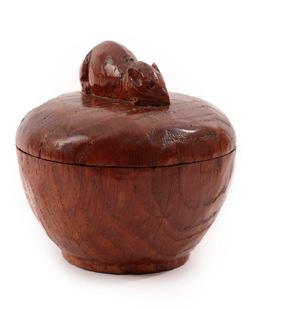

7



6 2

1: English oak anthropomorphic mouse figure, workshop of Robert ‘Mouseman’ Thompson. Sold by Tennants for £13,000. 2: English oak sideboard, Robert ‘Mouseman’ Thompson, c.1920. Sold by Tennants for £8,000. 3: English oak mantel clock, Robert ‘Mouseman’ Thompson, c.1930. Sold by Tennants for £6,500. 4: English oak writing table, Robert ‘Mouseman’ Thompson, c.1940-1950. Sold by Tennants for £10,000. 5: Set of 12 octagonal English oak napkin rings, workshop of Robert ‘Mouseman’ Thompson, post 1960. Sold by Tennants for £950. 6: English oak owl holding a mouse in its talons, workshop of Robert ‘Mouseman’ Thompson, 1967. Sold by Tennants for £7,500. 7: English oak powder bowl and cover, Robert ‘Mouseman’ Thompson. Sold by Tennants for £5,200. 3
4
5
These are now highly collectable, especially the more unusual ones. A 26cm-high figure of a mouse modelled as a wood carver fetched a staggering £13,000 when it went under the hammer at Tennants Auctioneers in Leyburn in March this year, establishing a new auction record for a ‘Mouseman’ carving.
The figure was carved by George Weightman, who was one of the most gifted of Robert Thompson’s protégés and renowned for the quality of his work, explains Diane Sinnott, Tennants’ 20th Century Design Specialist.
Oak is notoriously difficult to carve; figures such as this one took hundreds of hours to make and were never a cost-effective proposition for the ‘Mouseman’ workshop, says Diane. They were made as promotional pieces, designed to catch the eye of passers-by at the Great Yorkshire Show. Such items are incredibly rare, hence the record-breaking price.
Little and Large
As well as rarity, age plays a role in determining value, with pre-1955 pieces generally attracting a premium. Interestingly, though, current auction values don’t necessarily reflect an item’s original purchase price. “The bigger pieces aren’t so commercial,” explains Diane. “Massive tables and sideboards are harder to find a home for, so something like a powder bowl or a set of napkin rings can make as much as, or more than, a huge dining table.
“Likewise smaller, more practical pieces of furniture – such as the lovely writing desk we sold last year for £10,000 – can make more money than tables twice their size.
“And when it comes to tables, the kind of oak that was used is also an important factor. Burr oak, with its gorgeous knotty patterning, will attract more interest than standard quarter-cut oak.”
Whilst a few ‘Mouseman’ pieces sold at auction go abroad, the majority stay here in the UK. Not surprisingly there’s a very strong following amongst Yorkshire folk and others who have fond memories of the area, including former students at Ampleforth College.
Captivating Critters
Robert Thompson inspired a whole generation of talented followers and imitators, now known collectively as the ‘Yorkshire Critters’ school, and they too are now attracting the attention of collectors. First and foremost amongst them is Stan ‘Woodpecker’ Dodds (1928–2012).
Stan became an apprentice at Robert Thompson’s workshop at the age of 14, and continued to work there until he retired in 1994. He also had his own workshop where he made oak carvings in his spare time, signing them first with a carved rabbit and subsequently with a woodpecker.
Stan was one of the ‘Mouseman’ workshop’s best carvers, and his figural pieces include otters, elephants and shire horses. He is now keenly collected in his own right, both for his ‘Mouseman’ work and for the work he did in his own right. A figurine of an owl holding a mouse in its talons sold at Tennants for the very respectable sum of £7,500 earlier this year.
For more information about Tennants Auctioneers, or to arrange a valuation, visit tennants.co.uk or call 01969 623780.
• Ornate plaster restoration • Cornice manufacture • Traditional lime plastering • Lime rendering techniques • Historical plasterwork surveys • Lath and plaster ceiling repairs • Heritage work on listed buildings • Bespoke design service

We have a national reputation for manufacturing and installing the very best heritage, traditional and contemporary plasterwork. Whether you are looking for a ceiling rose or cornice to t your period property, repairs to damaged existing plaster detail, the large-scale restoration of a historic property or a bespoke design to reinstate traditional decorative plaster features, we can help.
A DEDICATED TEAM OF SKILLED PLASTER CRAFTSMEN BASED IN NORTH YORKSHIRE
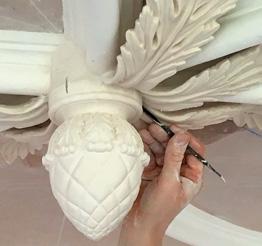
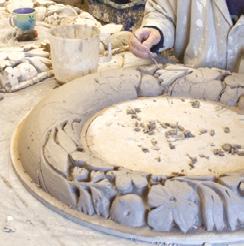
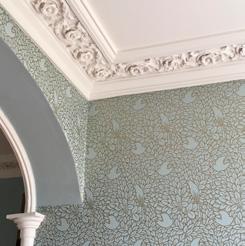
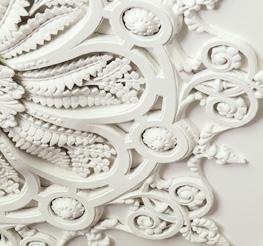
Visit our website and watch our videos, follow us on twitter, say hi on Facebook. Or just give us a call and tell us what you want.










